HR Analytics Market Size
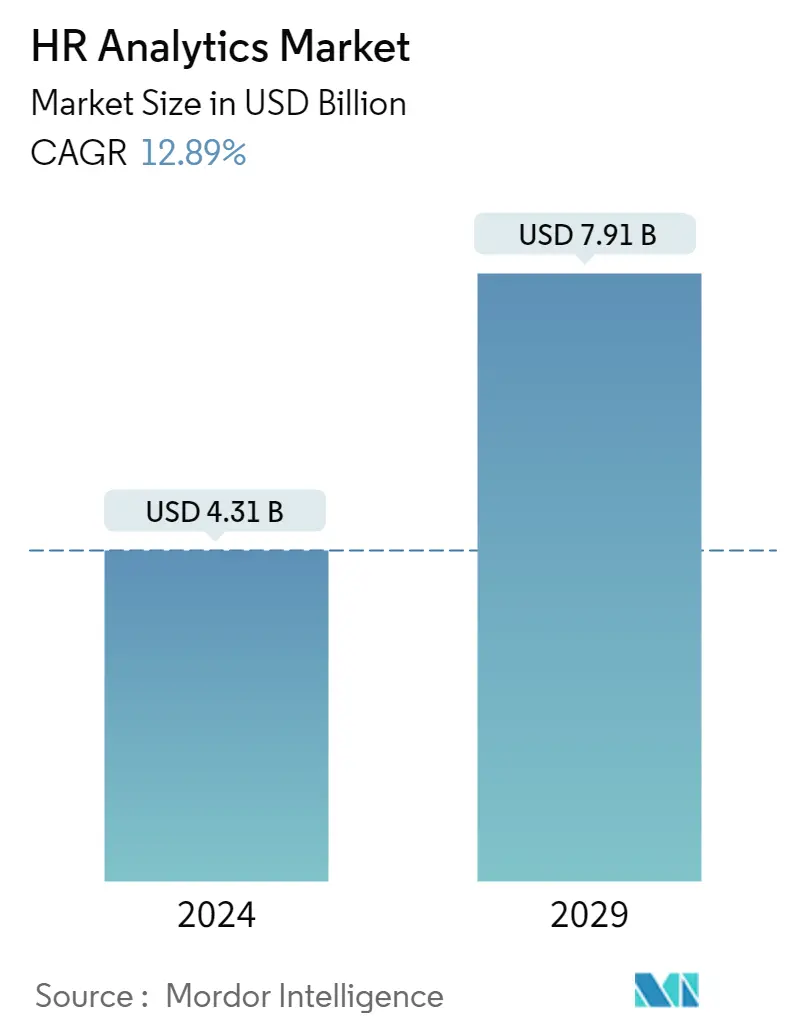
| Study Period | 2019 - 2029 |
| Market Size (2024) | USD 4.31 Billion |
| Market Size (2029) | USD 7.91 Billion |
| CAGR (2024 - 2029) | 12.89 % |
| Fastest Growing Market | Asia Pacific |
| Largest Market | North America |
Major Players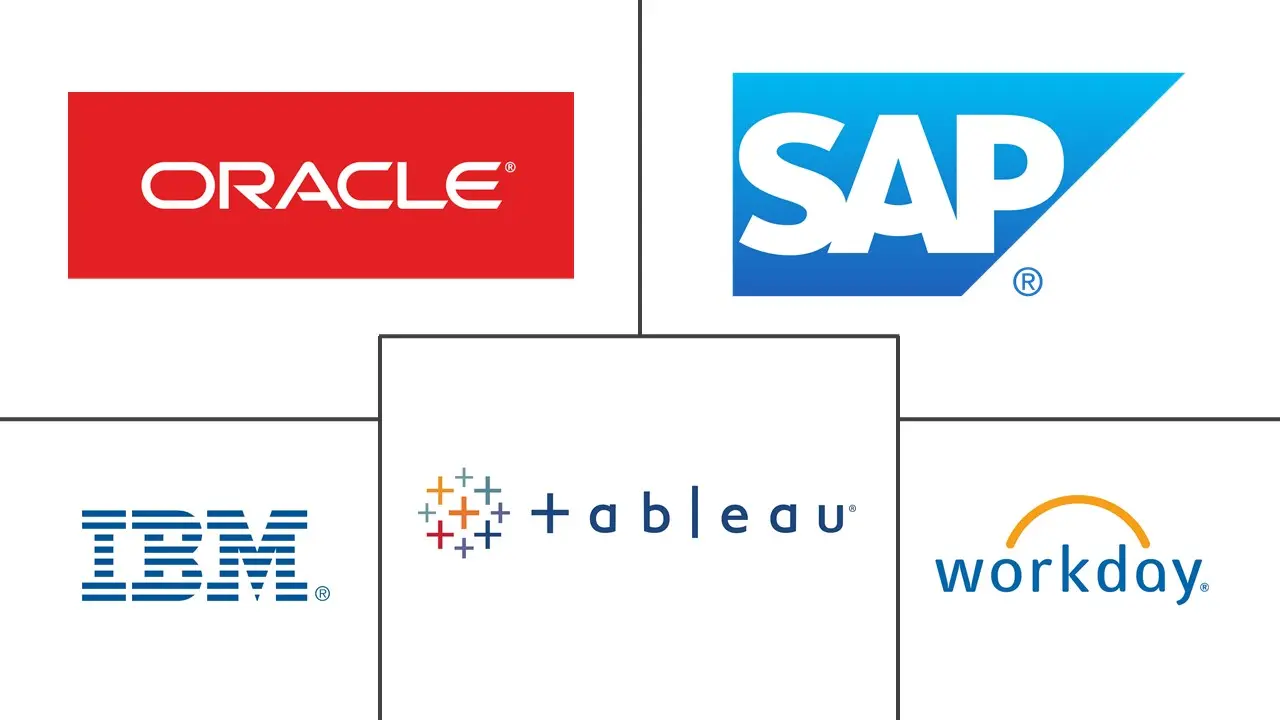
*Disclaimer: Major Players sorted in no particular order |
HR Analytics Market Analysis
The HR Analytics Market size is estimated at USD 4.31 billion in 2024, and is expected to reach USD 7.91 billion by 2029, growing at a CAGR of 12.89% during the forecast period (2024-2029).
By using data gathered, HR analytics aids in improving the productivity of HR services by making predictions about crucial factors, including performance, retention, and recruiting. These elements are all driving the market's expansion.
- By using HR analytics, HR departments can make data-backed decisions when it comes to managing attrition and spot areas where automation can be introduced. They can leverage the solution capabilities to capture insights on employee feedback forms. HR analytics can also implement artificial intelligence recruiters to automate interview scheduling, provide real-time feedback to employees, and improve the handling of Big Data HR analytics. This will not only help HR executives to save time but also money.
- One of the most important applications of HR analytics is the prediction of sick leaves or days off. For instance, the provider of financial protection benefits, Unum Group, launched a pilot project with the illness forecast application provider, Sickweather. The project identifies correlations between Sickweather's data from its real-time human health map and Unum's Family and Medical Leave Act (FMLA) and coded sick leave paid time off (PTO) data to forecast employee illness-related absence.
- Identifying the current and future skill gaps is another application for HR analytics. Mexico's Ministry of Energy uses a predictive workforce planning and analytics model to learn about the current shortage of skilled workers in the oil and gas industry and predict one over a 10-year horizon. The industry also started using workforce planning and analytics for renewable energy and sustainability in such sectors.
- One of the biggest challenges faced by organizations around the world is the management of people and talent. While continuing to work on improving hiring procedures, employee satisfaction, payroll issues, and retrenchment, an HR professional needs to keep everyone on the same page and still manage to get things done as expected by the company and managers. Due to the introduction of data analytics in HR processes, the approach has become simpler than ever, proving to be a major advantage for HR in their everyday work.
- The employee benefits trends survey by Metlife found that 72% of workers would desire limitless vacation time as a benefit. However, HR analytics can assist in making sure that employees are taking enough time off following the organization's regulations. HR analytics can also assist in monitoring each employee's overtime hours.
- The trend towards remote work has been gradually growing for the past few years. However, COVID-19 has dramatically accelerated this trend in an extremely short period of time, forcing companies, irrespective of their size, to adapt quickly to the self-isolation measures that governments across the globe were recommending. With the pandemic requiring much more people to work remotely, analytics solutions are becoming essential for companies as these solutions can help in managing the remote workforce efficiently and provide the ability to track the status of the workforce so that the company can report and analyze these trend and impact on the business.
HR Analytics Market Trends
This section covers the major market trends shaping the HR Analytics Market according to our research experts:
Telecom and IT Industry is Witnessing a Significant Share in the Market
- Data analysis assists HR in managing the full talent lifecycle by looking into competitive benchmarking, competency gap analysis, learning opportunities, workforce patterns, talent demands, etc. The human resource function is expanding from both a technological and an analytics perspective. Additionally, enterprises are being helped by Artificial Intelligence (AI), Machine Language (ML), and Natural Language Processing (NLP) to see and analyze data holistically rather than just linearly, employing various tools and algorithms to solve business problems.
- IT and telecom have been seen in a negative light for the past few years when it comes to attrition rates. For instance, in companies such as Uber and Dropbox, the average tenure of a tech employee is 1.8 years and 2.1 years, respectively. HR analytics is helping these organizations with the ability to understand various industry trends, and multiple organizations are deploying advanced analytics solutions to improve employees' experience.
- Numerous firms' IT teams are quickly becoming overburdened with requests for training, user support, and reporting. Ad hoc reporting burdens on analysts can be decreased using Business Intelligence (BI) solutions, which can improve data security for the company and cut down on time spent on help desk support. Therefore, companies in this industry rely on the appropriate tactics and tools to guarantee that employees have the necessary skills and fit their organizational culture. This is the main factor influencing the IT industry's adoption of HR analytics.
- The telecom industry has adopted advanced analytics to manage its customer base, enhance value propositions, and create new products. Moreover, operators are just beginning to apply analytics. However, the telecom industry is turning increasingly to technological innovations to upgrade its recruitment and engagement strategies. It started leveraging HR analytics solutionsto achieve organizational and people effectiveness throughout the entire organization.
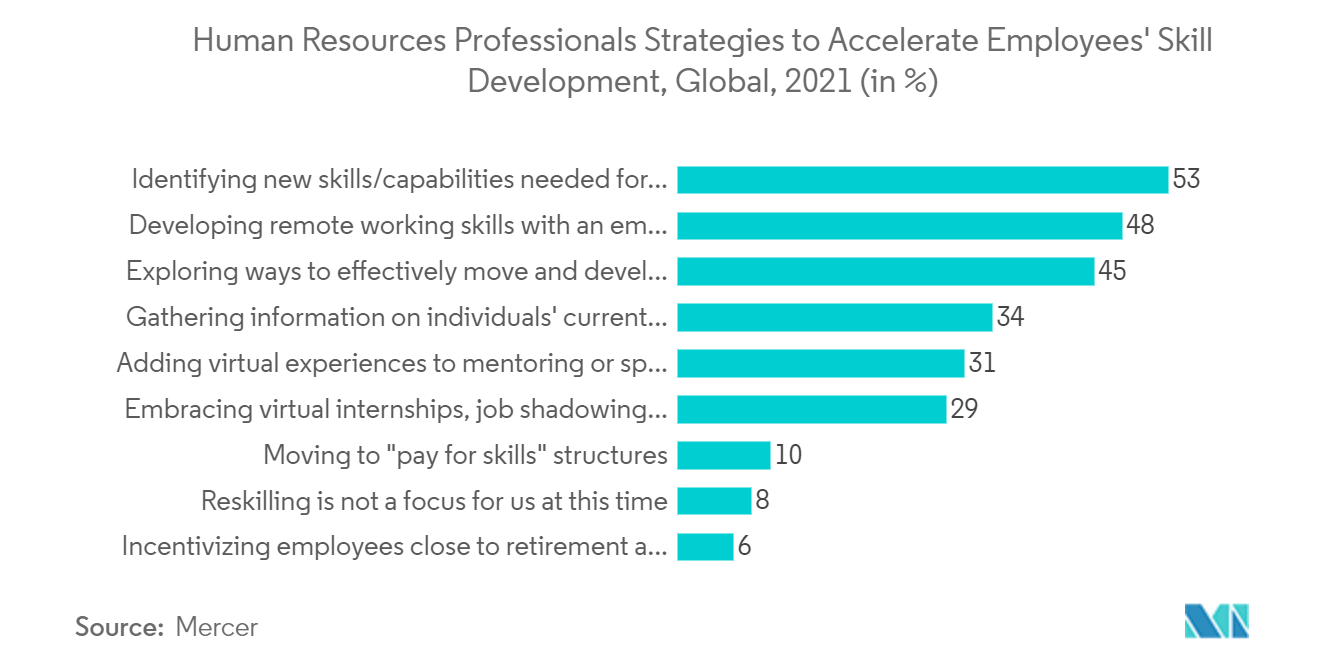
North America to Hold the Significant Share in The Market
- Over the past few years, HR analytics has had considerable acceptance in North America. This is due to the fact that more large regional companies are employing cloud infrastructure and that there are significant HR analytics vendors in the region, such as IBM Corporation.
- For instance, LinkedIn published a report stating that it has found a 3x increase in HR professionals from North America who list analytics skills and similar keywords in their profile in the last five years.
- The survey further claims that it has discovered a concentrated use of HR analytics in North America, with banking holding the highest adoption and tech software holding the lowest adoption, compared to other industries like architecture, spectrum, and manufacturing.
- Additionally, New York, Washington, DC, and San Francisco are among the top regions in North America with a high adoption rate of HR analytics, with a greater emphasis on benefits, productivity, compensation, and performance across diverse industries. For instance, cities like Washington, DC that have the highest levels of skill scarcity use HR analytic tools for workforce planning.
- It is recommended that educational and professional institutions in the US review their course offerings to include HR analytics courses in creating subject matter experts. The excellent findings from their students' research will contribute to the body of knowledge on HR analytics and give businesses a platform for developing HR solutions to employee management problems. However, the lack of awareness and adoption of HR analytics across industries such as the public sector due to its continuum phase and the impact of the recent global pandemic COVID-19 with organizations halting their recruitments in the region, may hinder the growth of the market.
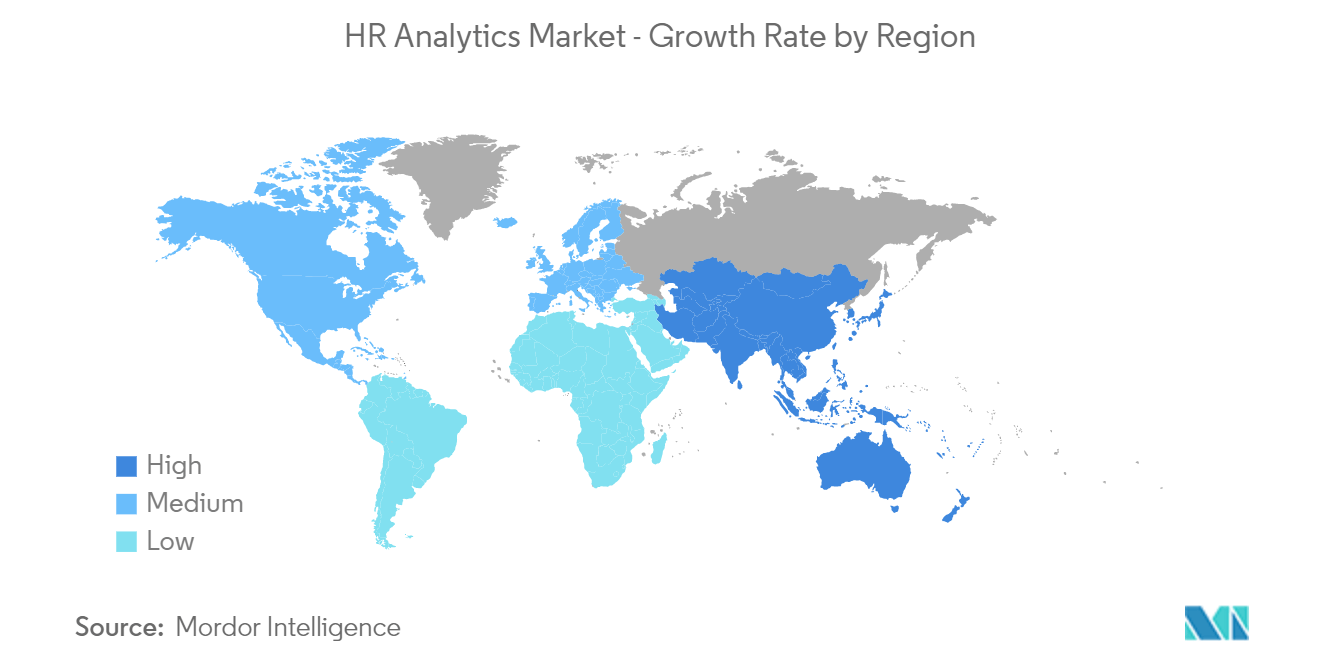
HR Analytics Industry Overview
HR Analytics Market is moderately fragmented with the presence of major vendors, including SAP SE, Oracle Corporation, and IBM Corporation. The vendors are enhancing the product line by leveraging strategic collaborative initiatives and acquisitions as a competitive advantage to expand their customer base and gain market share. Thus, market concentration is medium
In August 2022, Workday Inc., a leader in enterprise cloud applications for finance and human resources, announced that Workday Scheduling and Labor Optimization has been named a winner of Human Resource Executive's 2022 Top HR Products of the Year competition.
In July 2022, SAP SE announced that it had acquired Askdata, a startup focused on search-driven analytics. With the acquisition of Askdata, SAP strengthens its ability to help organizations make better-informed decisions by leveraging AI-driven natural language searches. Users are empowered to search, interact and collaborate on live data to maximize business insights.
HR Analytics Market Leaders
-
SAP SE
-
IBM Corporation
-
Oracle Corporation
-
Tableau Software Inc.
-
Workday Inc.
*Disclaimer: Major Players sorted in no particular order
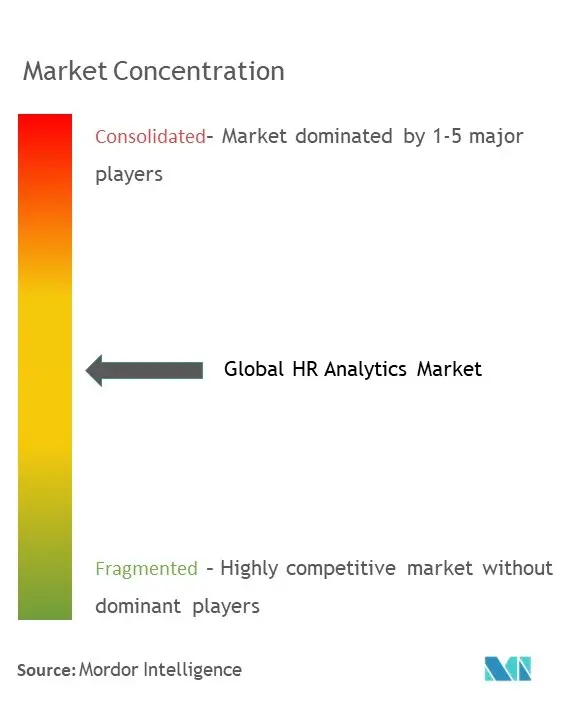
HR Analytics Market News
- June 2022: GainInsights, a global data and analytics firm announced it has signed an agreement with DataSwitch, an emerging AI/ML-driven Data Transformation Platform, to accelerate analytics modernization initiatives through data pipeline innovation and accelerators for migration.
- May 2022: Visier, people analytics and on-demand solution for people-powered businesses established a strategic agreement with Deloitte. By combining cutting-edge technology with world-class consulting, Deloitte and Visier can provide business clients with guidance and professional services support throughout their HR analytics journey.
HR Analytics Market Report - Table of Contents
1. INTRODUCTION
- 1.1 Study Assumptions and Market Definition
- 1.2 Scope of the Study
2. RESEARCH METHODOLOGY
3. EXECUTIVE SUMMARY
4. MARKET INSIGHTS
- 4.1 Market Overview
-
4.2 Industry Attractiveness - Porter's Five Forces Analysis
- 4.2.1 Bargaining Power of Suppliers
- 4.2.2 Bargaining Power of Consumers
- 4.2.3 Threat of New Entrants
- 4.2.4 Threat of Competitive Rivalry
- 4.2.5 Intensity of Substitutes
- 4.3 Assessment of COVID-19 Impact on the Industry
5. MARKET DYNAMICS
-
5.1 Market Drivers
- 5.1.1 Increase in Trends in Cloud-based Solutions
- 5.1.2 Increase in Workforce and Need for Reduction in Attrition Rate
-
5.2 Market Challenges
- 5.2.1 Lack of Skilled Workforce
6. MARKET SEGMENTATION
-
6.1 By Component
- 6.1.1 Solutions
- 6.1.2 Services
-
6.2 By Deployment Mode
- 6.2.1 On-Premise
- 6.2.2 Cloud
-
6.3 By End-User Industry
- 6.3.1 Telecom and IT
- 6.3.2 BFSI
- 6.3.3 Consumer Goods and Retail
- 6.3.4 Healthcare
- 6.3.5 Manufacturing
- 6.3.6 Other End-user Industries
-
6.4 By Geography
- 6.4.1 North America
- 6.4.1.1 United States
- 6.4.1.2 Canada
- 6.4.2 Europe
- 6.4.2.1 Germany
- 6.4.2.2 United Kingdom
- 6.4.2.3 France
- 6.4.2.4 Rest of Europe
- 6.4.3 Asia Pacific
- 6.4.3.1 India
- 6.4.3.2 China
- 6.4.3.3 Japan
- 6.4.3.4 Rest of Asia Pacific
- 6.4.4 Latin America
- 6.4.4.1 Brazil
- 6.4.4.2 Argentina
- 6.4.4.3 Rest of Latin America
- 6.4.5 Middle East and Africa
- 6.4.5.1 United Arab Emirates
- 6.4.5.2 Saudi Arabia
- 6.4.5.3 Rest of Middle East and Africa
7. COMPETITIVE LANDSCAPE
-
7.1 Company Profiles
- 7.1.1 SAP SE
- 7.1.2 Oracle Corporation
- 7.1.3 Workday Inc.
- 7.1.4 Tableau Software Inc.
- 7.1.5 IBM Corporation
- 7.1.6 Nakisa Inc.
- 7.1.7 Zoho Corporation Pvt. Ltd
- 7.1.8 Kronos Inc.
- 7.1.9 Gaininsights Solutions Pvt. Ltd
- *List Not Exhaustive
8. INVESTMENT ANALYSIS
9. MARKET OPPORTUNITIES AND FUTURE TRENDS
** Subject To AvailablityHR Analytics Industry Segmentation
HR analytics refers to applying the analytic process to the human resource department's talent data to measure the performance and efficiency that matters to HR the most to drive better returns on investment. It deals with gathering data, and providing insights into each process to make relevant managerial decisions. The data may include the number of people trained, the number of people with certain competencies, and the number of candidates to have in the pipeline based on the estimated attrition among others to help managers to deliver compliance and diversity reports.
The HR Analytics Market is segmented by Component (Solutions and Services), Deployment Mode (On-Premise and Cloud), End-user Industry (BFSI, Telecom & IT, Consumer Goods & Retail, Healthcare, and Manufacturing), and Geography (North America (United States, and Canada), Europe (Germany, United Kingdom, France, and Rest of Europe), Asia-Pacific (India, China, Japan, and Rest of Asia-Pacific), Latin America (Brazil, Argentina, and Rest of Latin America), and Middle East and Africa (United Arab Emirates, Saudi Arabia, and Rest of the Middle East and Africa))
The market sizes and forecasts are provided in terms of value (USD million) for all the above segments.
| By Component | Solutions | |
| Services | ||
| By Deployment Mode | On-Premise | |
| Cloud | ||
| By End-User Industry | Telecom and IT | |
| BFSI | ||
| Consumer Goods and Retail | ||
| Healthcare | ||
| Manufacturing | ||
| Other End-user Industries | ||
| By Geography | North America | United States |
| Canada | ||
| By Geography | Europe | Germany |
| United Kingdom | ||
| France | ||
| Rest of Europe | ||
| By Geography | Asia Pacific | India |
| China | ||
| Japan | ||
| Rest of Asia Pacific | ||
| By Geography | Latin America | Brazil |
| Argentina | ||
| Rest of Latin America | ||
| By Geography | Middle East and Africa | United Arab Emirates |
| Saudi Arabia | ||
| Rest of Middle East and Africa |
HR Analytics Market Research FAQs
How big is the HR Analytics Market?
The HR Analytics Market size is expected to reach USD 4.31 billion in 2024 and grow at a CAGR of 12.89% to reach USD 7.91 billion by 2029.
What is the current HR Analytics Market size?
In 2024, the HR Analytics Market size is expected to reach USD 4.31 billion.
Who are the key players in HR Analytics Market?
SAP SE, IBM Corporation, Oracle Corporation, Tableau Software Inc. and Workday Inc. are the major companies operating in the HR Analytics Market.
Which is the fastest growing region in HR Analytics Market?
Asia Pacific is estimated to grow at the highest CAGR over the forecast period (2024-2029).
Which region has the biggest share in HR Analytics Market?
In 2024, the North America accounts for the largest market share in HR Analytics Market.
What years does this HR Analytics Market cover, and what was the market size in 2023?
In 2023, the HR Analytics Market size was estimated at USD 3.82 billion. The report covers the HR Analytics Market historical market size for years: 2019, 2020, 2021, 2022 and 2023. The report also forecasts the HR Analytics Market size for years: 2024, 2025, 2026, 2027, 2028 and 2029.
HR Analytics Industry Report
Statistics for the 2024 HR Analytics market share, size and revenue growth rate, created by Mordor Intelligence™ Industry Reports. HR Analytics analysis includes a market forecast outlook to 2029 and historical overview. Get a sample of this industry analysis as a free report PDF download.



